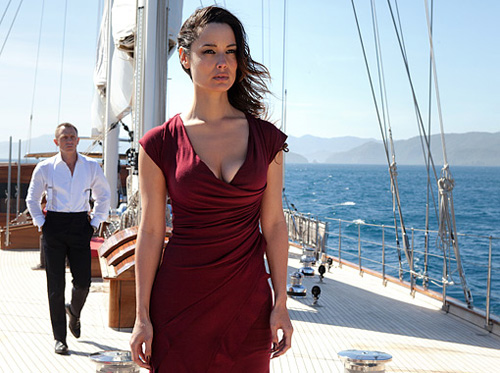The de-evolution of Bond girls
Over the past 50 years, the James Bond movies have earned more than $6.5 billion. During the same time period, the so-called Bond Girls have been given a chauvinistic shove backwards.
This started modestly when director Terence Young cast 30-year-old Sean Connery to play Bond in the low-budget 1962 film version of Ian Fleming’s popular spy novel, “Dr. No.” Impressed with the “devil-may-care” attitude Connery exhibited in their first meeting, Young dressed the actor in evening clothes and personally guided him to the posh nightclubs, casinos and beautiful women of London where, in the words of script writer Ray Benson, Connery learned to act “dapper, witty, and above all, cool.”
Cast for her knockout female form (both her speaking and singing voices were dubbed in the film), the Swiss actress Ursula Andress personified the quintessential Bond Girl, Honey Wilder. The first time Bond (and the audience) sees Honey, she is emerging from the blue Jamaican sea wearing a white bikini and a dagger on her hip. More importantly, the first Bond Girl was not only beautiful, she was a powerful, empowered woman able to take care of herself—even willing to kill, if necessary. In short, she was Bond’s equal.
This becomes evident in Bond and Honey’s conversation on the beach:
“I’m pretty sure Dr. No killed my father,” Honey says.
After a few more questions, Bond asks, “Didn’t anyone in Kingston help?”
“Well, there was this man who owned the place we were living. Then one night he came up to my room… Well, you know… I scratched his face…but he was stronger than I was.”
“And what happened after that?”
“I put a black widow spider under his mosquito net. A female. They’re the worst. It took him a whole week to die. Did I do wrong?”
Bond pauses before answering with British aplomb, “Well it wouldn’t do to make a habit of it.”
I shared this scene in a workshop that Hollywood Assistant Director and Sebastopol native Cynthi Stefenoni and I presented at the 2nd Annual Women’s PowerStrategy Conference last weekend. The audience responded to my prompts for reactions to this scene with: “it’s very revealing,” and “they had a real conversation.” One woman commented she was “surprised at how shocked Bond appears to be when he hears of her rape.” (and, I would add, Honey’s venomous revenge).
We then showed the first meeting between the newest James Bond (Daniel Craig) and the exotically beautiful Severine (Berenice Marlohe) in the latest Bond film, Skyfall. With his “shaken, not stirred” martini in front of him, Bond tells Severine, “You’re scared,” and when she tries to leave, he grabs her wrist to reveal a tattoo.
“Macau sex trade,” he says. “You belonged to one of the houses. What were you? Twelve? Thirteen? I’m guessing he was your way out. Perhaps you thought you were in love. But that was a long time ago.”
“You know nothing about it.”
“I know when a woman is afraid and pretending not to be.”
“How much do you know about fear?”
“All there is.”
“Not like this…Not like him.”
“Bring me to him.”
“Can you kill him?”
“Will you?”
Severine then tells Bond her three bodyguards have been instructed to kill him. If he survives, she is staying on a boat that will leave the harbor in one hour.
Cynthi shared her behind-the-camera analysis of how the filmmakers created the moods in the two different scenes: Connery and Andress are shown in wide shots with a comfortable space between them on a sunny beach under wind-rustled, palm trees. They are having a conversation between equals, punctuated by an occasional smile or shoulder shrug.
In contrast, Craig and Marlohe are shot in tight, over-a-shoulder close-ups in a crowded nightclub accompanied with the sounds of drinking and gambling. The yellow candlelight leaves dark and menacing shadows in the background. This newest Bond never smiles. He stares fixedly at the woman seated next to him. He is the Alpha Male. He is in command—restraining her with a strong grip on her wrist and attacking her vulnerability as a disposable, sexual object.
In 1962, the first Bond Girl was accepted by an engaged and interested Bond as his equal. In 2012, the newest Bond Girl is viewed by a cold, unfeeling Bond as just a disposable prostitute.
Comments? E-mail [email protected].









